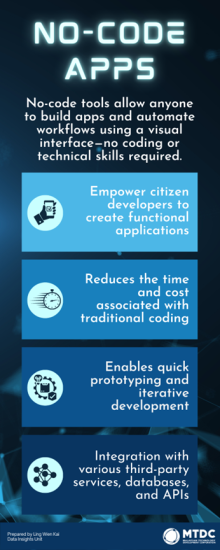Introduction
As part of an organisation’s digital transformation journey, digital automation plays a crucial role. In my earlier article, I discussed Robotic Process Automation (RPA), one of the emerging intelligent automation technologies identified in Deloitte’s Global Intelligent Automation Survey. (Polner et al., 2022)
However, when it comes to implementing automation technologies in the next three years, executives surveyed show a higher preference for no-code and low-code apps. They were twice as likely to prioritise the adoption of no-code and low-code apps compared to RPA, as indicated in Figure 1. Moreover, 24 percent of respondents had already implemented low-code in 2020, which increased to 40 percent in 2021.

Figure 1: Results from Deloitte’s Global Intelligent Automation survey showing planned implementation of emerging intelligent automation technologies in the next three years (Polner et al., 2022)
About No-code Apps and Low-code Apps
No-code tools do exactly what you would expect: they allow individuals and companies to build web-based products without writing any code. (Cohen, 2022) These tools come with customisable templates, and allow changes to be made using just drag-and-drop functionality. You can create user interfaces, define workflows, integrate with external services, and deploy your app—all through a visual interface. The underlying code is then automatically generated, relieving users from the task of writing code themselves.
Similarly, low-code automation speeds up the process by eliminating developer grunt work. Low-code tools generate developer-friendly front-end code, allowing them to follow along and make edits as needed, and easily extract code for individual components. (Cohen, 2022) These platforms have given rise to “citizen developers”, (McKendrick, 2022) defined by Gartner (2022) as an employee who creates application capabilities for consumption by themselves or others, using tools that are not actively forbidden by IT or business units. A citizen developer is a persona, not a title or targeted role. They report to a business unit or function other than IT.
Benefits of No-code Apps
According to No-Code Platforms for Enterprises, n.d., no-code provides businesses with many benefits, such as:
- Decreasing Time to Market
No code offers rich functionality and the ability to turn projects around in a fraction of the time it would take if built using traditional or low-code options.
- Promoting Transparency and Cross-team Collaboration
No-code allows business teams to see what is being built by IT teams in real-time, ensuring that nothing gets lost in translation.
- Accessible, Breaking Down Barriers Between Business Teams and IT
IT work has been inaccessible to those without specialised knowledge. No-code flips this model by making everyone a part of the app development process regardless of experience.
- Flexibility: Build on Your Own Terms
No-code platforms give you the flexibility to start building immediately, with full flexibility to adjust on the fly and completely redirect when necessary.
- Cost Savings: Reduce Legacy Maintenance
Legacy maintenance can be a huge drain on an IT department’s resources and company funds. No-code works alongside existing legacy systems, allowing developers to keep what works and change what does not. This results in faster builds with zero maintenance costs.
Potential Risks of No-code Apps
While the emergence of no-code and low-code tools significantly improves productivity, it is important that we recognise and plan for their potential before adopting new digital automation technologies.
- Platform Limitations
Citizen developers are limited to the functionalities offered by the no-code platform they are using. There could be certain functionalities that are difficult to implement on certain platforms, such as more complex workflows that are unique to the organisation.(Bas, 2023)
- Platform Dependence
Building an app on no-code platforms makes a startup or an enterprise dependent on a third party technology provider. Factors like price, service quality, and security are beyond the control of the user. (Bas, 2023)
- Security and Governance Risks
Potential vulnerabilities are introduced when these tools establish unregulated connections between an organisation’s central systems and third-party applications. Citizen developers may lack the larger context and knowledge around application security, data governance, and compliance, and this is further amplified when these applications become connected with one another. (Jackson, 2023)
The Best No-code App Builder Software
Zapier, a popular web application integrator and workflow automation platform, identified the following five best no-code app builders to use in 2023: (Rebelo, 2023)
- Softr for complete beginners
- Bubble for a balance between power and ease of use
- Google AppSheet for leveraging AI and automation
- Glide for creating simple mobile apps
Backendless for advanced control over your data and infrastructure.
Observation
Businesses and individuals alike are operating in an increasingly complex digital world, fuelled by the need for rapid app development and the desire to make software creation accessible to a wider audience. As a result, the no-code and low-code development industries have witnessed remarkable growth in recent years.
According to Gartner, the no-code and low-code platform market experienced an average annual growth rate of over US$1 billion. Moreover, Gartner forecasts the worldwide low-code development technologies market to reach US$26.9 billion in 2023, reflecting a significant 19.6 percent increase from the previous year. (DeLisi & Howley, 2022) Given this impressive market growth, it is clear that no-code and low-code approaches are going to become even more ubiquitous in the coming years.
Organisations that wish to stay competitive and remain at the forefront of digital innovation must recognise the strategic importance of incorporating no-code and low-code development into their digital automation plans. By embracing these technologies as early as possible, businesses can leverage the benefits they offer while also develop a plan for mitigating potential risks.

References
Bas, A. (2023, February 20). Pros and cons of no-code development. https://www.sommo.io/blog/pros-and-cons-of-no-code-development
Cohen, A. (2022, January 17). No code vs low code: Key differences for developers. Anima Blog. https://www.animaapp.com/blog/industry/will-no-code-replace-developers/
DeLisi, M. R., & Howley, C. (2022, December 13). Gartner Forecasts Worldwide Low-Code Development Technologies Market to Grow 20% in 2023. Gartner. https://www.gartner.com/en/newsroom/press-releases/2022-12-13-gartner-forecasts-worldwide-low-code-development-technologies-market-to-grow-20-percent-in-2023
Gartner. (2022). Definition of Citizen Developer—Gartner Information Technology Glossary. Gartner. https://www.gartner.com/en/information-technology/glossary/citizen-developer
Jackson, A. (2023, January 4). Council Post: Understanding The Growth And Risks Of Low-Code/No-Code Solutions. Forbes. https://www.forbes.com/sites/forbestechcouncil/2023/01/04/understanding-the-growth-and-risks-of-low-codeno-code-solutions/
McKendrick, J. (2022, November 3). Low-code no-code market keeps growing, and that means shifts in technology roles. ZDNET. https://www.zdnet.com/article/low-code-no-code-market-keeps-growing-portending-shifts-in-technology-roles/
No-Code Platforms for Enterprises: 5 Key Benefits | Unqork. (n.d.). Retrieved May 26, 2023, from https://www.unqork.com/resources/blog-articles/five-key-benefits-of-no-code-platforms-for-enterprises
Polner, A., Wright, D., Thopalli, K., Telford, T., Urbaniak, T., & Schaefer, G. (2022). Automation with Intelligence (2022). Deloitte. https://www2.deloitte.com/content/dam/insights/articles/gb-164901-emea-intelligent-automation/DI_Automation-with-intelligence.pdf
Rebelo, M. (2023, January 27). The 5 best no-code app builders in 2023 | Zapier [Blog]. Zapier. https://zapier.com/blog/best-no-code-app-builder/
